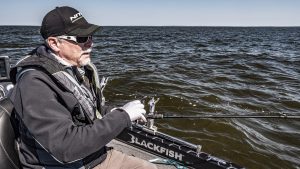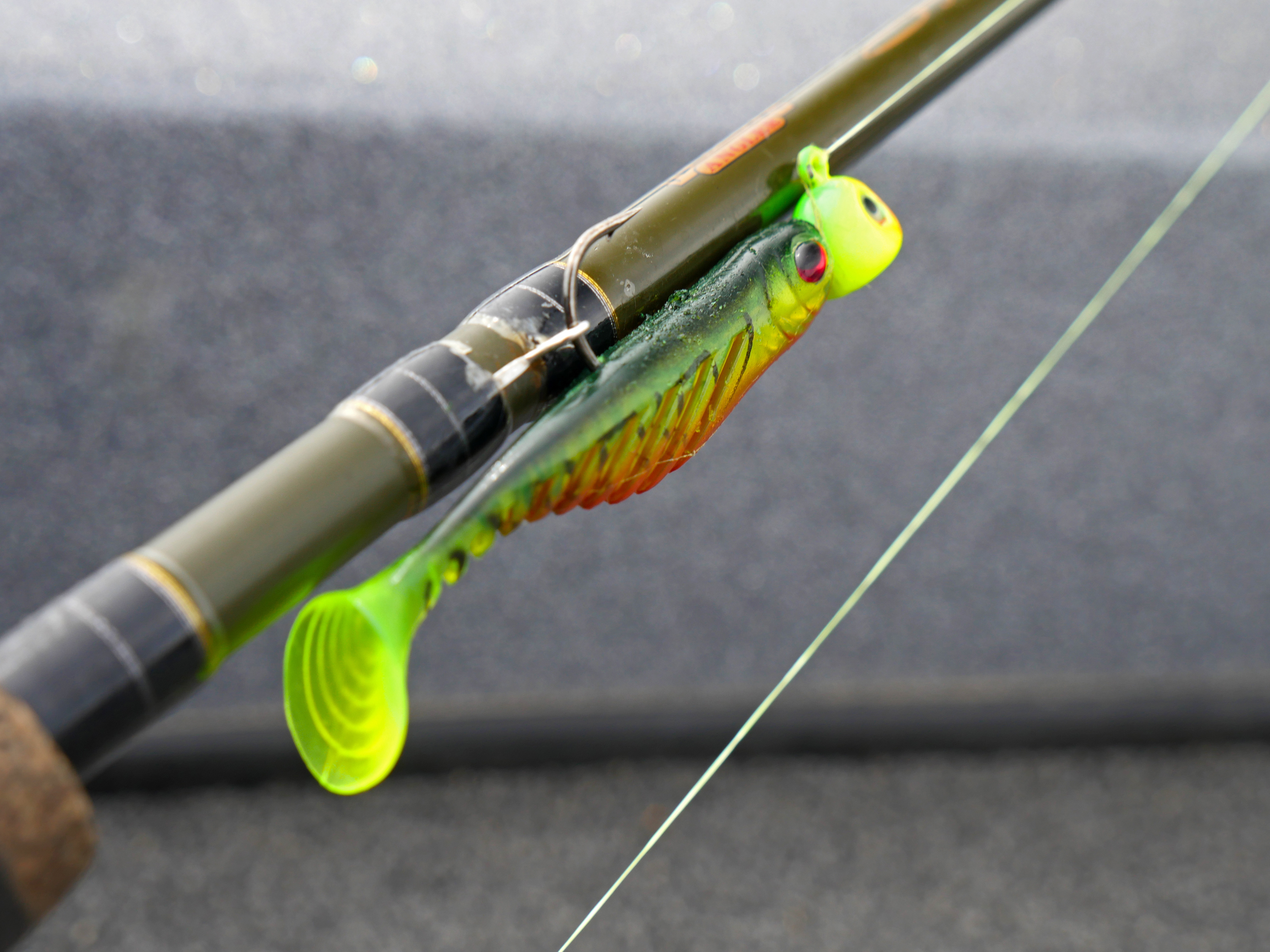
Fishing a new lake for walleye this fall, better bring the lead core. Big groups of fish rest on specific contours or in the basin of most lakes and covering shallow water areas for that first few bites means running fast. Rivers are classic options for lead core and checking a wide variety of areas and depths suits the presentation perfectly. Tie on a Flicker Shad, Jointed Flicker Shad, or Flicker Minnow and get going.
Lead core is one of those methods that sounds easy but takes time to develop proficiency. Two boats side-by-side with the same setup could end up with vastly different catch rates. There is a certain level of “feel” that one needs to have for success that will only develop over time.
Deeper lead core trolling works great in the fall because more and more panfish move towards the basin as the water cools. Walleye follow this migration. Look for areas where the wind has pushed plankton and bait into a shoreline area, point, or bay and start graphing. Our Nitro V21 boats stay on plane at 20 mph and graphing extensive contours and basin areas for fish is easy. We set our Lowrance HDS Live 2D sonar show bottom, the areas where fall walleyes live. At faster speeds the fish show up as spikes or triangles rising out of the bottom (when slower, these spikes turn back into arches). Make sure your ping speed is set to maximum, and your scroll speed is set to 2X. Generally, the fish hold at a specific contour or simply at the bottom of a drop off edge nearest the deepest basin in the area, so drive around until you find a depth pattern. It still amazes us that so many fish can sit in a small basin or extend for two or more miles on a consistent contour.
Long, 10 to 14-foot rods used to be the norm but telescoping rods fit better in rod lockers and take less time to set up on the water. The Cabelas Depthmaster 9-foot telescopic trolling rod does a great job of managing the extra weight of the line while indicating lure action and vibration. Combine these rods with the Cabelas Depthmaster Metal line counter reels in the 30 size and Bass Pro Shops 18-lb Magibraid lead core. The key part of the system is the rod tip. The best rods vibrate wildly when the crankbait runs true and stop vibrating when the lure has fouled.
Trollers use all three types of fishing line for leaders. Braided line like Berkley Fireline transmits the most information to the rod. At times, fluorocarbon or monofilament catch more fish so do not be afraid to change leaders on one, or all of the rods throughout the day. It used to be common to run 30 to 50-foot leaders on lead core but most walleye anglers do two arm-lengths. This should be 10-12 feet of line which seems to work.
For the first few passes start with 10-lb test Fireline leaders and a high-action lure like a Flicker Shad Jointed. The extra action on the lure and the no-stretch leader makes it obvious if the lure has fouled or is dragging on the bottom of the lake. With the boat moving at 2.0 mph or so let out 5 to 10 feet of line and test the lure for tuning accuracy. Pull the lure through the water and watch if the crankbait drifts to one side or the other. If it does, bend the eye of the lure with pliers of the Off Shore tuning tool a tiny amount in the opposite direction of the drift. While doing this, feel the action of the bait in your hand as this will be an important test later in the presentation.
Calculate the line needed to reach bottom by systematically letting out line, while holding the tip of the rod near the water level… slowly thumb the line while letting out a bit more line than you think you’ll need to bounce bottom for the first pass. The Precision Trolling App will get you in the right depth area. As an example, stop shy of 110 feet and check if the bait tugs on the rod while digging the bottom of the lake. Cranks running through water have a consistent vibration while occasional pulls indicate the lure has touched bottom. If no tugs, then let out 15 more feet of line and check again. Once the bait yanks a few times, reel up two to three cranks. This places the lure slightly above the lake bottom and in the perfect position to trigger a walleye strike.
Feeling the yank of the bottom, the vibration of a true-running crankbait, and then the tug of a fish are critical parts of the lead core equation. Some anglers also watch the bend in the rod and the vibration level of the rod tip. Different lures wiggle the tip varying amounts so learning to see a baseline amount sets great anglers apart.
Lead core is very speed-dependent. If the boat slows down, the line pulls down the baits. A perfectly set lure is now digging bottom. Speeding up has the opposite issue and the lures are now out of the strike zone. Speed control used to be tough but when combining a kicker motor and a speed-control-enabled trolling motor like the Motor Guide Xi5 and speeds stay within a few tenths of a mile per hour for miles on end.
It is still up to the angler to follow a contour or adjust for the depth of the basin. Moving to a deeper contour brings the lures off the bottom and strikes cease. Generally, one angler pays close attention to boat control while the other checks lure details. Every few minutes let out 10 feet of line and check that the lure tugs bottom and reel back a couple of turns. If the vibration in the rod tip stops pick up the rod and sweep it through the water to feel for the lure vibration checked earlier. At this point decide if the lure needs to come back to the boat to be cleared of the leaf, grass, or algae causing the trouble. Between constant attention to depth and lure presentation a good team can consistently trigger bites from fish throughout the day.
Basin and deep contour fish stay notoriously particular about lure color and vibration. Change lures often and adjust speeds if needed. This is the time to have boxes of all lure types including the different versions from the Flicker family (Shad, Minnow, and Jointed) as well as the Berkley Digger. An alternative to crankbaits is to run swimbaits on 1/2-ounce or larger Berkley Swimbait Jig Heads. These run best at slower speeds but often trigger more bites than traditional crankbaits.
Eventually, all of these details add up with a fish putting a big bend in the rod and signaling The Next Bite.










